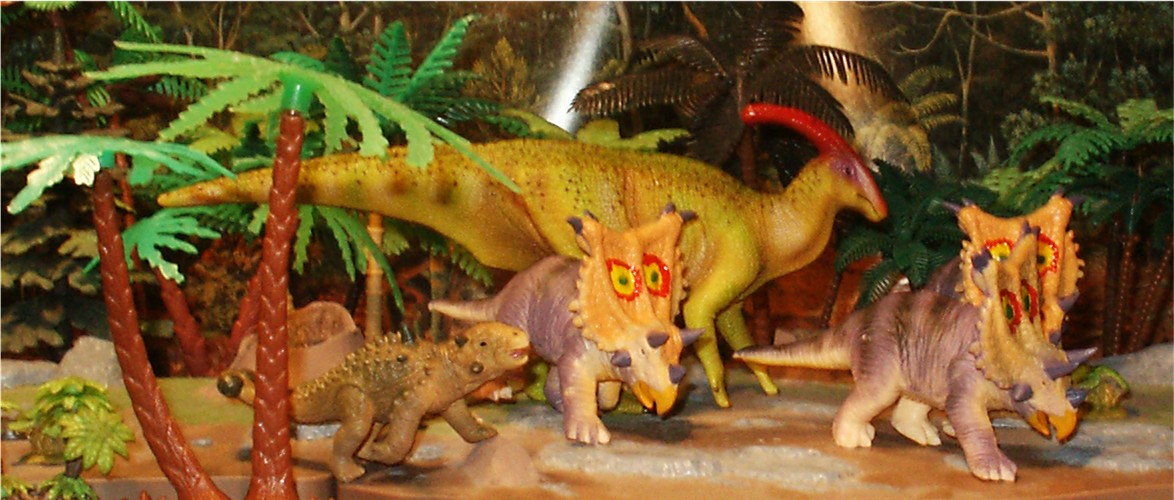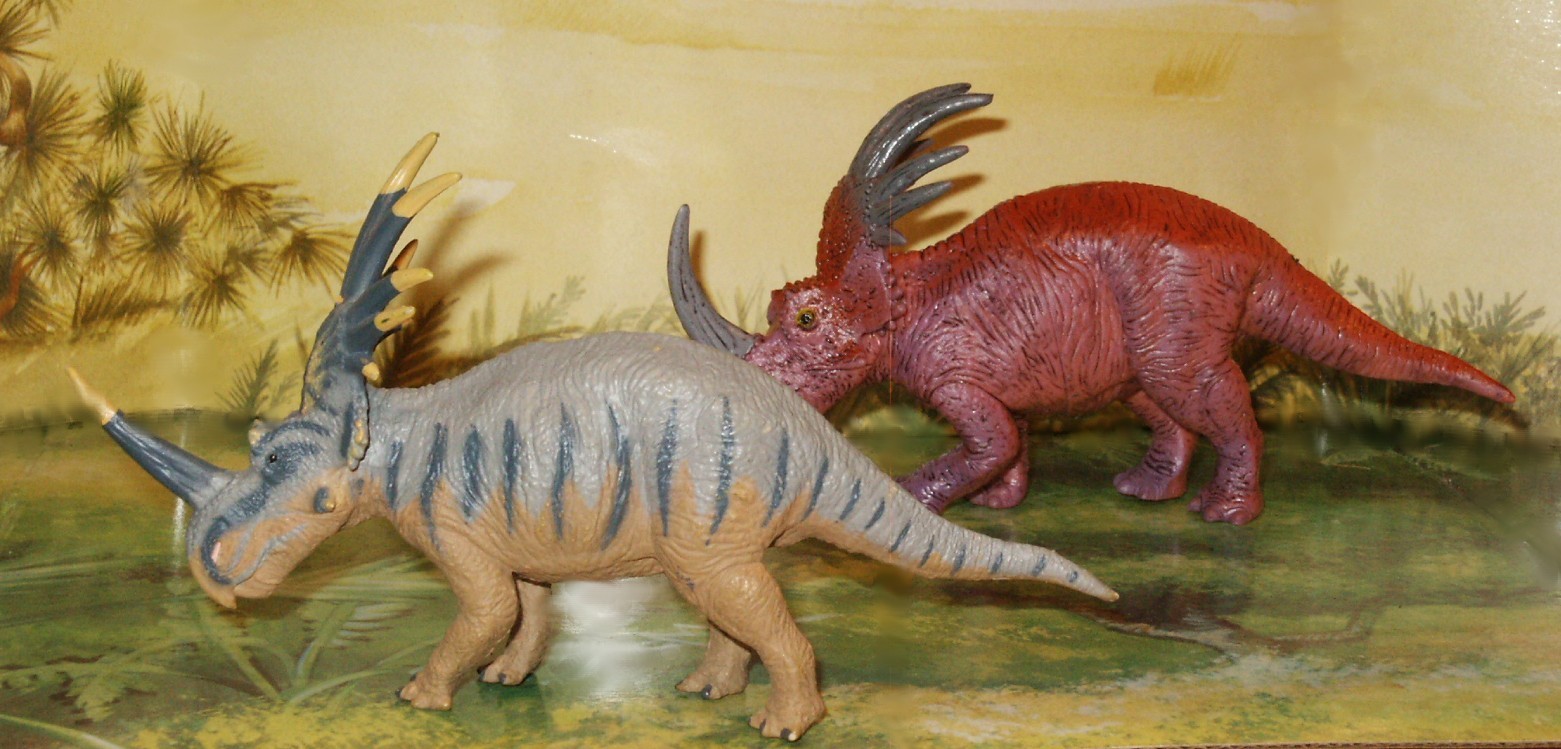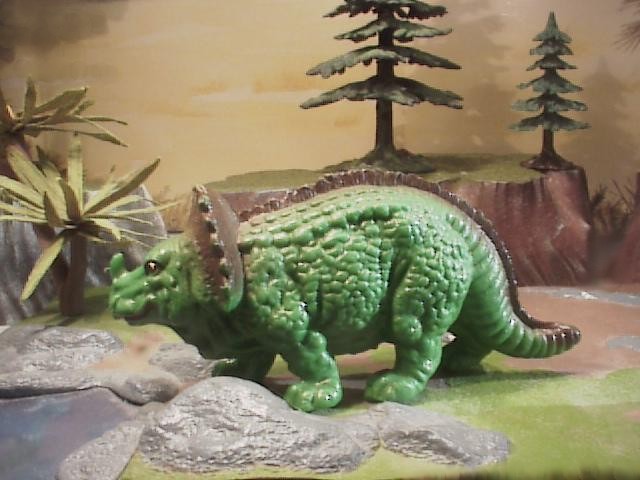
Late Cretaceous Campanian
Judith River Formation
83 - 74 mya
from the Dinosaur Collector updated 09/12/08
The Judith River Group at Dinosaur Provincial Park is an example of a very high diversity dinosaur assemblage; no known community anywhere demonstrates a comparable diversity. In the Campanian of Judith River of Alberta, common horned dinosaurs are the chasmosaurine, Chasmosaurus, the the centrosaurines Styracosaurus and Monoclonius. Centrosaurus and Anchiceratops were also present.
Albertosaurus at 27 feet long, was a smaller version of Tyrannosaurus, lighter and probably faster, with puny arms but more teeth in a relatively broad snout. It probably preyed upon hadrosaurs and Stegoceras. It may have been been displaced when Tyrannosaurus migrated from Asia later in the Cretaceous. Struthiomimus had drooping front legs with long toes. It had powerful curved claws on fingers and lived on river banks, forests, sandy plains and humid lowlands. It had a long toothless jaw similar to modern birds, and may have had a horny beak and perhaps also ate plants. It was perhaps able to run at up to 40 km/h

Schleich Styracosaurus and Albertosaurus with a Kabaya Struthiomimus.
Chasmosaurus (Cleft Lizard) wide spread medium size (17 feet)
animal in Western US. Several species have been identified based on differences
in the horn sizes. One the best known dinosaurs with many complete
skeletons. Possibly the ancestor to Torosaurus that show up later in the
same ranges.
 Chasmosaurus and Euplocephalus from the Oriental Trading company. Chasmosaurus has not been a common subject for toy companies. Triceratops and Styracosaurus filled the need for a
horned dinosaur in most lines. Note the Oriental Trading company version
actually is labeled Styracosaurus. Parasaurolophus from the Kinto My Favorite Collection made
available through the generosity of Healthstones hobbies.
Chasmosaurus and Euplocephalus from the Oriental Trading company. Chasmosaurus has not been a common subject for toy companies. Triceratops and Styracosaurus filled the need for a
horned dinosaur in most lines. Note the Oriental Trading company version
actually is labeled Styracosaurus. Parasaurolophus from the Kinto My Favorite Collection made
available through the generosity of Healthstones hobbies.
Styracosaurus was a relatively small at 18 feet, it was a horned dinosaur
with a greatly extended neck frill and prominent nose horn. Large bone
beds of centrosaurine and chamosaurine dinosaurs indicated that that at least at
certain times they gathered together in great herds possibly for migrations like
today's Caribou or Wildebeests. 
The excellent Battat and a similar looking Waiphoon hollow vinyl Styracosaurus. Both figures follow the Marx style reconstruction.
Styracosaurus (Spiked Lizard) is though to be a herding animal like its relative Centrosasurus.

Bullyland Styracosaurus.
The best known of the ostrich dinosaurs is Struthiomimus. It was toothless and fast and about 12 feet long..

The Struthiomimus is from the second series of Choc Egg figures.
Horned dinosaurs are dived into two major families the centrosaurines with Styracosasurus being the most popular and the chamosaurines that include the
bigger and later Triceratops. The centrosaurines had large nasal horns and
small frills generally. Chasmosasurines tended to have large frills and
horns over the eyes being prominent.  The Wild Safari Styracosaurus is a robust figure. Also included in the
gray bin style vinyl figure from China.
The Wild Safari Styracosaurus is a robust figure. Also included in the
gray bin style vinyl figure from China.
Monoclonius one of the larger horned dinosaurs. The animals may have been very aggressive, based on a Pachyrhinosaurus skull with a severe head injury, evidence for which was apparent in that an extensive defect had scarred the right side of the face. It was determined that the animal most likely to have caused such a wound was a specimen of Monoclonius;

Left is the Marolin Monoclonius from Germany. The original figures were created in the 1920's but later reproduced by the East German Leipzig Museum.
Fossils are rare and most restorations are based on the better known Centrosaurus. The main difference being the lack of hooks at the top of the frill characteristic of Centrosaurus. Centosaurines disappear from fossil record in the later Maastrichtian.

Starlux Centrosaurus.
Pachycephalosaur's belong to the Marginocephalia. The Marginocephalia ("fringed heads") are a
clade of two main subgroups o the "bone-headed" pachycephalosaurs and the frilled ceratopsians.
Judith River has produced 2 bone heads Gravitholus and Stegoceras both about 10 feet long and mostly known from skulls. Like many other
smaller dinosaurs they may have lived in the uplands where few fossils are
preserved. FameMaster 4D Pachycephalosaurus thanks to the of the Dinosaur Farm.
The AAA Edmontonia sent by Sean Bell.
FameMaster 4D Pachycephalosaurus thanks to the of the Dinosaur Farm.
The AAA Edmontonia sent by Sean Bell.
return to Mesozoic Menu
Click on the Site A icon to the right for Dioramas organized by period or by manufacturer.